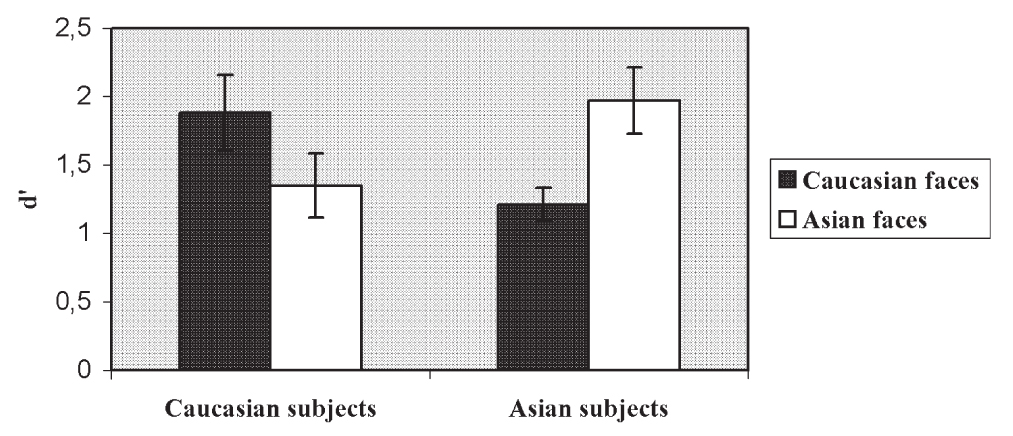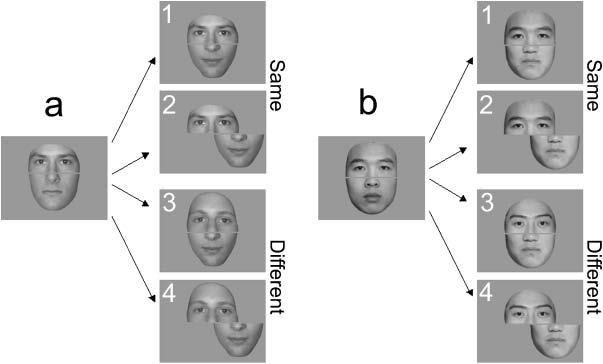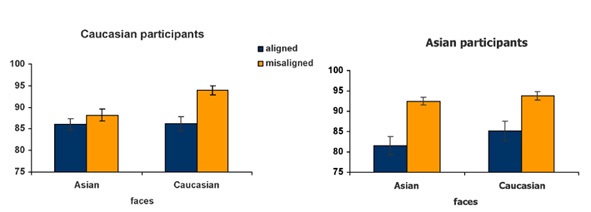Same- and other-race faces
General Description
Albeit sharing a highly similar structural organization (e.g. 2 symmetrical eyes above a central nose and a central mouth …), faces of different human populations encountered all over the world vary tremendously in terms of shape and surface cues (skin pigmentation, color, texture…).

Figure 1. A few members of the human race (left to right): Japan, Tibet, Borneo, Holland, New Zealand, Bali, Okinawa, Israel, Ireland, China, Rwanda, Korea, United States of America, Australia, India, Egypt. This figure has been copied from the ‘online edition of In the Beginning: Compelling Evidence for Creation and the Flood (7th Edition) by Dr. Walt Brown. Copyright © 1995–2006, Center for Scientific Creation.
While a large amount of variance in face structure of morphology (including pigmentation) can be observed between individuals of the same population, a substantial part of this variation appears to be related to our geographic origin: people from different parts of the world look different whereas people from the same part of the world tend to look similar. Skin color can go from pale white to dark brown for instance, while variations in shape can be equally dramatic (for example a smaller mouth width and a wider nose among Asians than among Caucasians; see Le et al., 2002; and Figure above). These differences probably reflect the evolution of the facial morphology to adapt to different environmental constraints over thousands of years (e.g. narrower nostrils to filter and warm up the air in cold countries; Cavalli-Sforza & Cavalli-Sforza, 1995). Thus, even though all modern humans are thought to have a common origin in the African continent and the different human populations separated geographically at most 200 thousands years ago (the ‘out of Africa model of modern human origin’, see Tishkoff & Verelli, 2003), living under different environmental constraints for this period was enough to create significant differences between populations in terms of their face (and body) morphology.
Even though these morphologic variations between human subpopulations allow us to quickly determine that a person (or his/her ancestors) originates from a different part of the world (e.g. ‘race’ categorization, e.g. Levin, 2000), they generally cause tremendous difficulties when we have to recognize faces of a different group at the individual level. We are not efficient at perceiving and encoding differences between people whose faces do not share the morphological features we are used to see in our everyday life. For example, an European white person who has spent most of his/her life in Western Europe will find that Asian faces look very similar to each other, and the opposite is true for a Chinese person who has not been much exposed to Caucasian faces (e.g. Brigham, Wasserman, & Meissner, 1999). This phenomenon is known as the ‘other-race face effect’ in the literature (e.g. Bothwell et al., 1989; Shepherd et al., 1974; for a recent meta-analysis see Meissner & Brigham, 2001). It suggests that our face processing system has been tuned very finely trough visual experience: the mechanisms developed to recognize individual faces of our own ‘race’ cannot be generalized efficiently to faces of another ‘race’.

Figure 2. Performance of Caucasian and Asian participants in an old/new recognition task with Caucasian and Asian faces (from Michel et al., 2006a). Both groups of participants presented a strong other-race effect, being much better for their own-race than for other-race faces.
Clarifying the mechanisms that our face processing system fails to generalize to other-race faces is particularly interesting, not only for the understanding of the other-race face effect, but also because it offers a window to understand better how our face processing system works in general (just like the study of prosopagnosic patients who have lost the ability to recognize faces gives important clues to understand the normal face processing system). In other words, contrasting the processing of same-race (SR) and other-race (OR) faces should increase our knowledge of the information (‘diagnostic cues’) we use to recognize faces (and that we do not encode efficiently for other-race faces). However, these differential processes that our perceptual system applies on SR versus OR faces have not been clearly identified so far.
In order to offer an integrated theoretical framework accounting for the other-race effect, we need to clarify the nature of the diagnostic information that we extract and encode efficiently on same-race faces and not on other-race faces.
Our contribution to this literature has been to show that same-race faces are processed more holistically (roughly, with a stronger integration of facial features) than other-race faces. We have demonstrated this differential holistic processing through two paradigms: the ‘whole-part advantage’ (Tanaka & Farah, 1993) and the ‘composite face effect’ (Young et al., 1987).

Figure 3. Examples of composite face stimuli used by Michel et al. (2006b). The top parts of the 2 Caucasian faces are identical but participants tend to perceive them as different, due to the influence of the bottom part. The two top parts of the Asian faces are also identical. The illusion is stronger for faces of our own race.
In both studies, we tested Caucasian and Asian participants showing clear other-race effects measured independently (see Figure 2). The results of our first study revealed that Caucasian participants processed Caucasian faces more holistically than Asian faces (a larger whole/part advantage for Caucasian faces; Michel et al., 2006a). However, Asian participants, who had been living among Caucasian faces (in Belgium) for one year on average processed both races of faces as holistically. In our second study, we measured the holistic processing of Asian and Caucasian faces in Asian and Caucasian participants having no particular experience with other-race faces. Both Asian and Caucasian participants processed same-race faces more holistically than other-race faces (a larger composite-face effect for same-race faces; see Figures 3, 4). However, this differential holistic processing was stronger in Caucasian than in Asian participants. Several factors may explain this difference, such as the exposure to Caucasian faces in the media (e.g., Hollywood movies) or a generally larger holistic processing of information in Easterners than in Westerners, as demonstrated in several studies (see Ji et al., 2000; Kitayama et al., 2003; Nisbett et al., 2001).

Figure 4. Main results obtained by Michel et al. (2006b) in the composite face task. The difference between the aligned (top and bottom parts) condition and the misaligned condition reflects the magnitude of the face composite effect.
To summarize, these two studies demonstrates directly that same-race faces are processed more holistically than other-race faces (see also Tanaka et al., 2004). Importantly, this does not mean that all the other-race effect could be accounted by this factor. Holistic processing is at least one factor by which same- and other-race face processing differ, but we are also certainly less sensitive to facial local features that are diagnostic to discriminate other-race faces.
Future work
The other-race effect must be due to a lack of visual experience at processing faces presenting phenotypical features that are clearly different from those of the faces one is used to see in everyday life (see Farkas, 2002).The critical role of visual experience is clearly demonstrated by experiments showing that Asian adults adopted in Western Europe during childhood (around 7 years of age) present a reversed other-race effect with respect to their ethnical origin: they do not recognize Asians faces as well as Caucasian faces (Sangrigoli et al., 2004).
However, the consequences of the lack of visual experience on our ability to process OR faces are still debated (Slone, Brigham, & Meissner, 2000). On the one hand, the lack of visual experience may lead to an inability of our face processing system to generalize the perceptual mechanisms from same-race to other-race faces (e.g. Rhodes et al., 1989). On the other hand, our extensive experience with same-race faces may lead us to emphasize category-membership when we are confronted with a face of a different race (‘It’s an Asian’). This emphasis may consequently drive the perceptual processes we apply on this face in a different way (and less efficiently) than when we are confronted with a face from our own race. In other words, even though our processing system would be able to apply more efficient mechanisms on this other-race face; ‘The problem is not that we can’t code the details of cross-race faces, it’s that we don’t’, Daniel Levin, Kent State University). Finally, both factors could be at work, accounting for the other-race face effect.
We have also shown that identical ‘racially-ambiguous’ faces (morphed face stimuli between an original Asian and an original Caucasian faces) are processed more holistically by Caucasian participants when they are expected to be Caucasian than Asian (see poster below). These results support the view that one’s categorization of a face as belonging to the same or another race plays a role in the differential holistic processing of SR and OR faces.

Figure 5. Examples of morphed face stimuli between asisan and Caucasian faces as used in Michel et al. (2010).
Most recently, we have tested the respective role of shape and texture cues in the other-race effect (i.e. what cues account most for the other-race effect?) in collaboration with Quoc Vuong and Isabelle Buelthoff at the Max Planck Institute in Tübingen (see Michel et al., in press)
Related Papers
Michel, C., Rossion, B., Bülthoff, I, Hayward, W., Vuong, Q. (in press). The contribution of shape and surface information in the other-race face effect. Visual Cognition. [PDF]
de Heering, A., de Liedekerke, C., Deboni, M., Rossion, B. (2010). The role of experience during childhood in shaping the other-race face effect. Developmental Science, 13, 181-187. [PDF]
Michel, C., Corneille, O., Rossion, B. (2010). Holistic face encoding is modulated by perceived face race: evidence from perceptual adaptation. Visual Cognition, 18, 434-455. [PDF]
Michel, C., Corneille, O., Rossion, B. (2007). Race categorization modulates holistic encoding. Cognitive Science, 31, 911-924. [PDF]
Michel, C., Caldara, R., Rossion, B. (2006). Same-race faces are perceived more holistically than other-race faces. Visual Cognition, 14, 55-73. [PDF] [slideshow summary]
Michel, C., Rossion, B., Han, J., Chung, C-S., Caldara, R. (2006). Holistic processing is finely tuned for faces of our own race. Psychological Science, 17, 608-615. [PDF] [slideshow summary]


